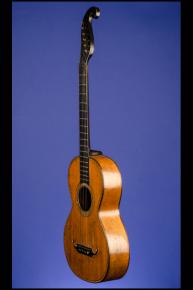1850s Markneukirchen "Stauffer Style" 'Parlor' Guitar
1850 Markneukirchen "Stauffer Style" 'Parlor' Guitar 12 fret to body.
This 1850s Markneukirchen "Stauffer Style" 'Parlor' guitar weighs just 2.50 lbs. and has an 11 3/4 inch wide 3 1/2 inch deep, figured 'Birds-Eye' maple, 'ladder-braced' body with a natural spruce top. The body depth at the neck is 2 3/4 inches, the upper bout measures 9 1/8 inches and the body length is 17 1/8 inches. The sound hole has a diameter of 3 1/4 inches and is bound with walnut, surrounded by two circular 'Herringbone' inlays and an intricate 'notched square' inlay ring (3/16 inch wide) of mother-of-pearl and abalone inlaid onto ebony. The edge of the top features a typical 'Martin-style', 3/16 inch wide purfling of maple and walnut. The back of the body has a 3/32 inch center stripe. On the strap-button edge of the body the ebony pin is situated on a 1/2 inch wide ebony strip.
Ebonized maple neck with 'ice-cream cone' heel and a scale length of 24 5/8 inches. The nut width is 1 3/4 inches and the 'D' neck profile is nice and thin with 0.78 inches at the first fret, 0.80 at the third fret and 0.85 inches at the ninth fret. Staufer style ebonized single bound maple 'scroll' peghead with original six-on-a side tuner mechanism and circular brass buttons. On the back of the peghead is the fine floral-engraved, silver tuner mechanism cover with eleven screws (four missing). Ebony fretboard with nineteen original? thin frets and neck joint at twelfth fret.
Original? metal saddle on 'Moustache' shaped ebony tailpiece with inlaid abalone circles at each end. Six ivory pins (some not original) with inlaid abalone circles.
There are four cracks on the top, which have now been repaired and are perfectly stable. The action at the twelfth fret is a little high at 3/16 inch. There is some playing wear on the top but overall this nearly two hundred year old guitar is in truly amazing condition.
Housed in a modern five-latch, shaped black hardshell case with burgundy plush lining (9.25)
Stauffer Guitar c.1820s. "C.F. Martin Sr. (1796-1873) worked for guitar-maker Johann Stauffer of Vienna - and not surprisingly, a Stauffer guitar from circa 1820 looks very much like the early Martin's, with its scrolled headstock, six-on-a-side tuner unit, 'moustache' bridhge ends, and relatively large upper bout. Martin & Schatz guitars were either made or marketed with Martin's friend from Markneukirchen, Heinrich Schatz, whom Martin followed to the United States in 1833 and who may have had an influence in the developement of X-pattern bracing. When Schatz moved to eastern Pennsylvania in 1835, Martin again followed him, buying a home that still stands today in Cherry Hill, just outside Nazareth…" (Walter Carter. A Complete History of Martin Guitars, pp. 18-19).
This guitar is featured in the Chinery Collection pp. 6-7 "(Attributed to) Stauffer. Produced: Austria, early 1800s. This example: c1820s".
"Guitar attributed to Stauffer c1820s. Johann George Stauffer (1778-1853) was born in Vienna, Austria. He became one of that country's most notable guitar makers, and in 1824 made a special instrument for the Austrian composer Franz Schubert. Christiain Friedrich Martin was a foreman at Staffer's shop during the 1820s, leaving the business in 1825. Eight years later Martin emigrated to the United States, absorbing much of the style and influence of Stauffer's instruments into the first guitars that he built there." (Walter Carter. The Martin Book, p. 10).
"This European guitar from the early 1800s, attributed to Stauffer of Vienna, has a top border that should look familiar to die-hard Martin fans - it is nearly identical to purfling used as the backstrip on some late-nineteenth-century Martins and on Style 42 and 45 models in the 1920s and 1930s. This pattern is still in use today on many contemporary Martin guitars. The conservative nature of Martin's stylistic evolution has left many continuous threads connecting Martin's features to Old World luthiers (Guitar courtesy of The Chinery Collection.) (Washburn & Johnston. Martin Guitars. An Illustrated Celebration of America's Premier Guitarmaker. p. 18).
"C.F. Martin Sr. (1796-1873) worked for guitar-maker Johann Stauffer of Vienna - and, not surprisingly, a Stauffer guitar from circa 1820 looks very much like the early Martins, with its scrolled headstock, six-on-a-side tuner unit, 'moustache' bridge ends, and relatively large upper bout. Martin & Schatz guitars were either made or marketed with Martin's friend from Markneukirchen, Heinrich Schatz, whom Martin followed to the United States in 1833 and who may have had an influence in the development of X-pattern bracing. When Schatz moved to eastern Pennsylvania in 1835, Martin again followed him, buying a home that still stands today in Cherry Hill, just outside of Nazareth." (Walter Carter. The Martin Book, p.19).
The Stauffer family
Johann Georg Stauffer (1778-1853) was the most important guitar-maker of the Viennese school. His "Legnani-modell" a guitar that he developed in cooperation with the famous guitar-virtuoso Luigi Legnani in 1821, was subject of numerous innovations and it was copied by guitar-makers in and outside Vienna for many more years.
His son Anton Stauffer (1805-1871) refines and markets the ideas of his father. The instrument shown above, a variation of the Legnani-model, he builds for almost 20 years until the end of the 1840s
















